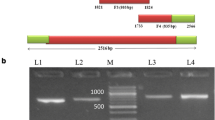Abstract
In tropical and subtropical regions of the world, parasitic diseases are major obstacle in the health and ultimately overall performance of animals. Cattle express heritable, contrasting phenotypes when exposed to ticks depicting genetic nature of trait. IFN-γ is one of the most reported genes critical for innate and adaptive immunity against viral and intracellular infections. To identify its role in resistance for ectoparasite especially tick, genetic characterization of this gene was done in resistant and susceptible animals of Sahiwal cattle (n = 95) and Friesian (n = 92). Nine Polymorphisms were identified, three of them were found in exonic region. One out of nine variants was being reported previously (ss82716193) and was confirmed in Pakistani Sahiwal cattle population as well. Single site analysis of each variant depicted their significance in tick resistant and tick susceptible groups (P < 0.05). The associations using haplotypes were more informative than for single markers. Eighteen different haplotypes resulting from nine polymorphic sites were used in construction of maximum parsimony tree which categorized resistant and susceptible animals in two clades. Genetic markers identified in this study can be useful in future breeding selection programs against tick resistance.


Similar content being viewed by others
References
Morris CA (2007) A review of genetic resistance to disease in Bos taurus cattle. Vet J 174:481–491
Ghosh S, Bansal GC, Gupta SC, Ray D, Khan MQ, Irshad H, Shahiduzzaman M, Seitzer U, Ahmed JS (2007) Status of tick distribution in Bangladesh, India and Pakistan. Parasitol Res 101:207–216
Trial JCM, Gregory KE (1981) Characterization of the Boran and Sahiwal breeds of cattle for economic characters. J Anim Sci 52:1286–1293
Moran MC, Nigarura G, Pegram RG (1996) An assessment of host resistance to ticks on crossed-bred cattle in Burundi. Med Vet Entomol 10:12–18
Evans DE, Martins JR, Guglielmone AA (2000) A review of the ticks (Acari, Ixodida) of Brazil, their hosts and geographic distribution. Mem Inst Oswaldo Cruz 95:453–470
Wambura PN, Gwakisa PS, Silayo RS, Rugaimukamu EA (1998) Breed associated resistance to tick infestation in Bos indicus and their crosses with Bos taurus. Vet Parasitol 77:63–70
Frisch JE, O’Neill CJ, Kelly MJ (2000) Using genetics to control cattle parasites—the Rockhampton experience. Int J Parasitol 30:253–264
Minjauw B, de Castro JJ (1999) Host resistance to ticks and tick-borne diseases: its role in integrated control. In: R.F.E., Bishop SC, Nicholas FW, Owen JB (eds) Breeding for disease resistance in farm animals. Oxford, UK, pp 153–169
Lewin HA, Russell GC, Glass EJ (1999) Comparative organization and function of the major histocompatibility complex of domesticated cattle. Immunol Rev 167:145–158
Abatepaulo ARR, Caetano AR, CTJr Mendes, Carvalho WA, Ferreira BR, de Miranda Santos IK (2008) Detection of SNPs in bovine immune-response genes that may mediate resistance to the cattle tick Rhipicephalus (Boophilus) microplus. Anim Genet 39:328–329
Gray PW, Goeddel DV (1982) Structure of the human immune interferon gene. Nature 298:859–863
Sambrook J, Russell DW (eds) (2001) Molecular cloning: a laboratory manual. Cold Spring Harbor Laboratory Press, Cold Spring Harbor, New York
Tatusova TA, Mizrachi IK, Ostell JA (1999) Complete genomes in WWW Entrez: data representation and analysis. Bioinformatics 15:536–543
Latif AA, Nokoe S, Punyua DK, Capstick PB (1991) Tick infestations on zebu cattle in Western Kenya: quantitative assessment of host resistance. J Med Entomol 28:122–126
Stear MJ, Newman MJ, Nicholas FW, Brown SC, Holroyd RG (1984) Tick resistance and the major histocompatibility system. Aust J Exp Biol Med Sci 62:47–52
Stear MJ, Hetzel DJS, Brown SC, Gershwin LJ, Mackinnon MJ (1990) The relationships among ecto- and endoparasite levels, class I antigens of the bovine major histocompatibility system, immunoglobulin E levels and weight gain. Vet Parasitol 34:303–332
Kerr RJ, Frisch JE, Kinghorn BP, Smith C, Gavora JS (1994) Evidence for a major gene for tick resistance in cattle. 5th world congress on genetics applied to livestock production, Guelph, Ontario, Canada 7-12th August (1994) 20:265–268
Abatepaulo ARR, Isabel KF, de Miranda Santos More DD, Carvalho WA, Caetano AR (2009) SNPs in bovine candidate genes for mediating resistance to infestations with the cattle tick. Vet Immunol Immunopathol 128:211–347
Author information
Authors and Affiliations
Corresponding author
Rights and permissions
About this article
Cite this article
Maryam, J., Babar, M.E., Nadeem, A. et al. Genetic variants in interferon gamma (IFN-γ) gene are associated with resistance against ticks in Bos taurus and Bos indicus . Mol Biol Rep 39, 4565–4570 (2012). https://doi.org/10.1007/s11033-011-1246-8
Received:
Accepted:
Published:
Issue Date:
DOI: https://doi.org/10.1007/s11033-011-1246-8




